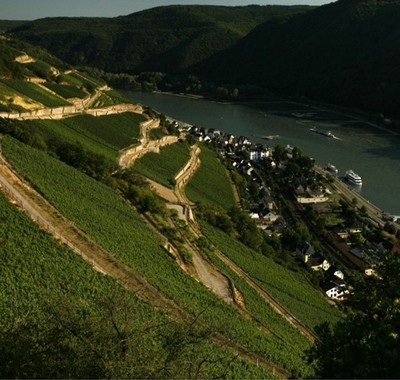Rheingau
The Rheingau is one of the most distinguished wine regions of the world.
Moving from east to west, the fairly flat, dimpled landscape evolves into progressively steep slopes. It is a quietly beautiful region, rich in tradition. Early on, its medieval ecclesiastical and aristocratic wine-growers were associated with the noble Riesling grape and, in the 18th century, were credited for recognizing of the value of harvesting the crop at various stages of ripeness from which the Prädikat, or special attributes that denote wines of superior quality, evolved. Queen Victoria's enthusiasm for Hochheim's wines contributed to their popularity in England, where they, and ultimately, Rhine wines in general, were referred to as Hock. The world-renowned oenological research and teaching institutes in Geisenheim have contributed significantly to the extraordinarily high level of technical competence in the German wine industry today. Two grape varieties predominate: the Riesling and the Spätburgunder. The former yields elegant wines with a refined and sometimes spicy fragrance; a fruity, pronounced acidity; and a rich flavor. The Spätburgunder wines are velvety and medium- to full-bodied, with a bouquet and taste often compared with blackberries.

Geographical location:
The Rhine Valley, along the 50° of latitude. The region is practically one long hillside on the northern bank of the river on its 30-km (20-mile) east-west journey from Wicker and Hochheim (near the confluence of the Main and Rhine rivers) to the river's bend at Rüdesheim and beyond, to the border with the Mittelrhein at Lorchhausen.
Major town(s):
Wiesbaden, Eltville, Rüdesheim.
Climate:
Mild winters and warm summers. The vineyards are protected from cold winds by the forest-capped Taunus Hills and benefit from the heat-reflecting surface of the Rhine.
Soil types:
Although the region is compact, there are many kinds of soil, including chalk, sand, gravel, all types of clay, loess, quartzite and slate.
Vineyard area (2003):
3,167 ha / 7,825 acres · 1 district · 10 collective vineyard sites · 100+ individual sites
Grape varieties [white 84.4% · red 15.6%] (2003):
Riesling (78.2%), Spätburgunder (12.7%), Müller-Thurgau (1.9%) as well as Ehrenfelser, Kerner and Weissburgunder.
Marketing:
Compared with other German wine regions, the Rheingau has a high proportion of full-time wine-growers; sales of bottled, rather than bulk, wine predominate; and much of the region's wine is sold directly to consumers. The region enjoys a broad domestic and international following.
Signposted routes through wine country:
Rheingauer Riesling Route (driving) · Rheingauer Riesling Pfad (hiking) · Rheingauer Radwanderweg (cycling)


